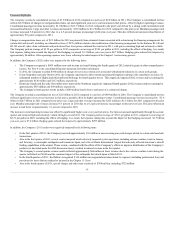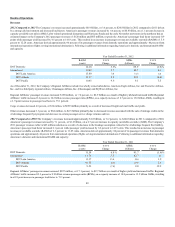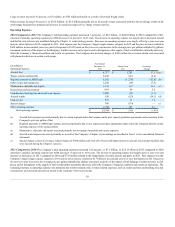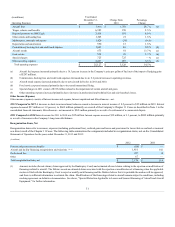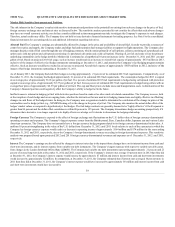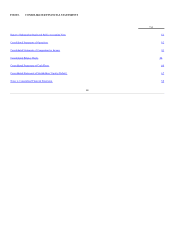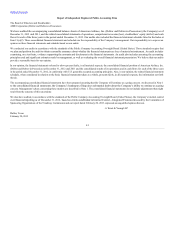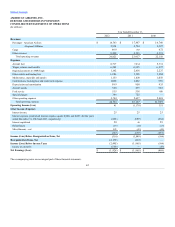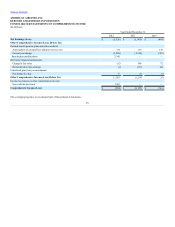American Airlines 2012 Annual Report Download - page 53
Download and view the complete annual report
Please find page 53 of the 2012 American Airlines annual report below. You can navigate through the pages in the report by either clicking on the pages listed below, or by using the keyword search tool below to find specific information within the annual report.
As previously reported, American experienced an unusually high number of pilot retirements in the fall of 2011 that resulted in capacity reductions for the
period November 2011 to February 2012.
Absent the impact of the capacity reductions in January and February of 2012 due to pilot retirements, consolidated capacity in the first quarter of 2013 is
estimated to be down 3.4 percent year-over-year.
First Quarter Unit Costs Guidance
AMR will continue to realize restructuring related savings and estimates that in the first quarter of 2013, unit costs will improve year-over-year, despite a
capacity headwind due to consolidated capacity decreasing by 1.7 percent and lapping some restructuring related savings that impacted the first quarter of last
year.
OTHER INFORMATION
Basis of Presentation
See Note 2 to the consolidated financial statements for information regarding the basis of presentation.
Critical Accounting Policies and Estimates
The preparation of the Company’s financial statements in conformity with U.S. GAAP requires management to make estimates and assumptions that affect
the amounts reported in the consolidated financial statements and accompanying notes. The Company believes its estimates and assumptions are reasonable;
however, actual results and the timing of the recognition of such amounts could differ from those estimates. The Company has identified the following critical
accounting policies and estimates used by management in the preparation of the Company’s financial statements: claims resolution process, long-lived assets,
international slots and route authorities, passenger revenue, frequent flyer program, stock compensation, pensions and retiree medical and other benefits,
income taxes and derivatives accounting.
Claims Resolution Process
Bankruptcy Rule 3003(c)(3) requires the Bankruptcy Court to fix the time within which proofs of claim must be filed in a Chapter 11 case pursuant to section
501 of the Bankruptcy Code. This Bankruptcy Rule also provides that any creditor who asserts a claim against the Debtors that arose prior to the Petition
Date and whose claim (i) is not listed on the Debtors' schedules or (ii) is listed on the schedules as disputed, contingent, or unliquidated, must file a proof of
claim. On May 4, 2012, the Bankruptcy Court entered an order that established July 16, 2012 at 5:00 p.m. (Eastern Time) (the Bar Date) as the deadline to
file proofs of claim against any Debtor. More information regarding the filing of proofs of claim can be obtained at www.amrcaseinfo.com. Information on that
website is not incorporated into or otherwise made a part of this report.
As of February 13, 2013, approximately 13,366 claims totaling about $290.0 billion have been filed with the Bankruptcy Court against the Debtors. Of those
claims, approximately 350 claims aggregating approximately $59 million were filed after the Bar Date. We expect new and amended claims to be filed in the
future, including claims amended to assign values to claims originally filed with no designated value. We have identified, and we expect to continue to identify,
many claims that we believe should be disallowed by the Bankruptcy Court because they are duplicative, are without merit, are overstated or for other
reasons, including that the claims were filed after the Bar Date. As of February 13, 2013, the Bankruptcy Court has disallowed approximately $100.2 billion
of claims and has not yet ruled on our other objections to claims, the disputed portions of which aggregate to an additional $14.8 billion. We expect to continue
to file objections in the future. Because the process of analyzing and objecting to claims is ongoing, the amount of disallowed claims may increase significantly
in the future. The Debtors have recorded amounts for claims for which there was sufficient information to estimate the claim.
Differences between amounts scheduled by the Debtors and claims by creditors will be investigated and resolved in connection with the claims resolution
process. In light of the expected number of creditors, the claims resolution process may take considerable time to complete. Accordingly, the ultimate number
and amount of allowed claims is not presently known, nor can the ultimate recovery with respect to allowed claims be presently ascertained.
Long-lived assets
The Company has approximately $14.1 billion of long-lived assets as of December 31, 2012, including approximately $13.3 billion related to flight equipment
and other fixed assets. In addition to the original cost of these assets, the recorded value of the Company’s fixed assets is impacted by a number of estimates
made by the Company, including estimated useful lives, salvage values and the Company’s determination as to whether aircraft are temporarily or
permanently grounded. In accordance with U.S. GAAP, the Company records impairment charges on long-lived assets used in operations when events and
circumstances indicate that the
53


